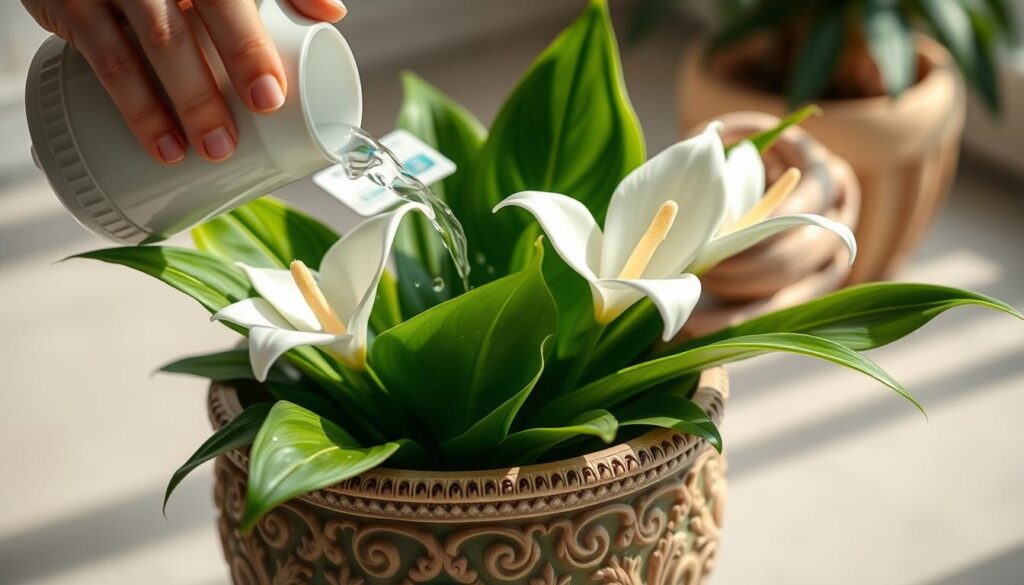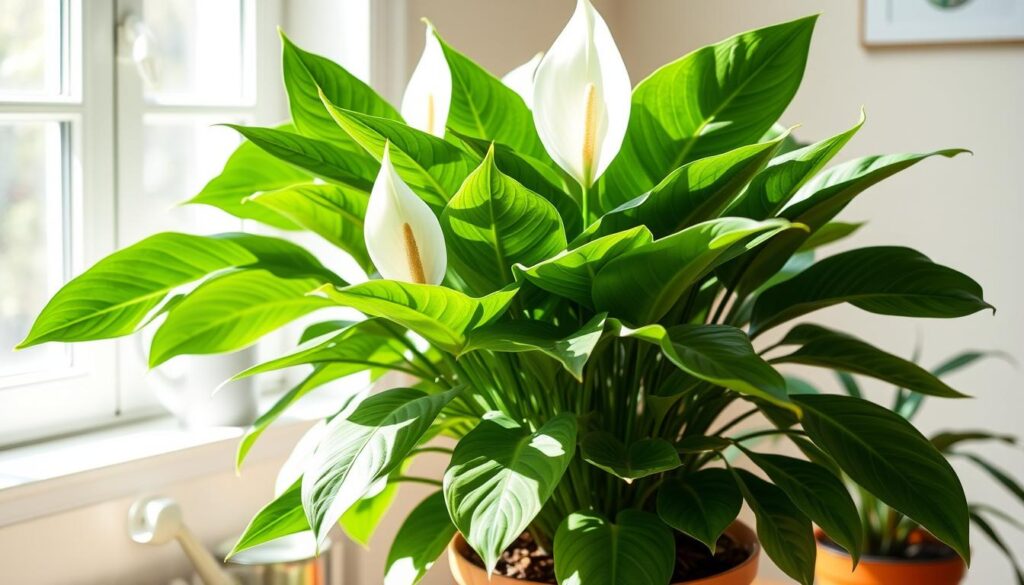Did you know peace lilies can purify indoor air up to 60% more than other houseplants? This fact makes them a top choice for those who care about beauty and health. I’m excited to share my insights on these air-purifying plants that are great for indoor gardening.
Peace lilies have shiny green leaves and pure white blooms. They come from the lush forests of Central and South America. These tropical plants have adapted well to life indoors, growing up to 3 feet tall and wide.
They fit perfectly in various spaces, from cozy corners to large living rooms. What’s fascinating about peace lilies is their versatility. They’re not just pretty; they also clean the air. These plants are perfect for homes and offices, improving air quality and adding elegance.
They can grow well in low light, making them a favorite among indoor gardeners. This makes them easy to care for, even for beginners.
Key Takeaways
- Peace lilies are powerful air purifiers, improving indoor air quality
- They thrive in various light conditions, from bright indirect to low light
- These plants can grow up to 3 feet tall and wide in indoor settings
- Peace lilies are versatile, suitable for both home and office environments
- They require minimal care, making them ideal for beginner plant parents
Introduction to Peace Lilies
Peace lilies are fascinating flowering plants that many indoor gardeners love. I’ve always been intrigued by these elegant plants. I’m excited to share what I’ve learned about them.
What are Peace Lilies?
Peace lilies aren’t actually true lilies. They belong to the Arum family and are tropical plants. These plants are known for their striking white blooms, which can last up to two months or more. The standard peace lily grows 24-40 inches tall, while some varieties like the Mauna Loa Supreme can reach impressive heights of four feet!
Origin and Natural Habitat
These beautiful plants come from the lush rainforests of Central and South America. In their natural habitat, peace lilies thrive on the forest floor. They adapt to dappled sunlight and high humidity. This is why they’re so well-suited to indoor environments, even tolerating rooms with no windows and flourishing under fluorescent lights.
Popularity as Houseplants
Peace lilies have become incredibly popular as houseplants, and it’s easy to see why. They’re low-maintenance, preferring temperatures between 65-85°F and enjoying humid climates. I’ve found that watering them once a week keeps the soil moist and the plant happy. Their air-purifying properties are an added bonus, making them a favorite choice for homes and offices alike.
| Feature | Detail |
|---|---|
| Size | 4″-6″ width, 8″-10″ height |
| Care Level | Easy |
| Fertilizer Frequency | Every six weeks |
| Watering | Allow soil to dry between waterings |
| Customer Rating | 4.8/5 (84 reviews) |
Peace Lily Varieties
Exploring the world of peace lilies shows me how diverse they are. These elegant plants come in many sizes and types. They fit well in various spaces and suit different tastes.
- Spathiphyllum wallisii: A compact option reaching about 12 inches tall, perfect for small spaces.
- ‘Petite’: An adorable variety growing 8-10 inches tall, ideal for desktop gardens.
- ‘Sensation’: A true showstopper, capable of growing 4-6 feet in height and width.
- ‘Domino’: A medium-sized variety featuring attractive variegated leaves.
- ‘Mojo Lime’: A unique peace lily with eye-catching lime-green foliage.
For those into miniature gardens, ‘Little Angel’ and ‘Piccolino’ are great picks. ‘Little Angel’ grows up to 15 inches tall with 5-inch wide leaves. ‘Piccolino’ reaches about 8 inches in height with a 4-inch spread.
| Variety | Height | Width | Special Features |
|---|---|---|---|
| Power Petite | 12 inches | 10 inches | Compact size |
| Wallisii | 16 inches | 18 inches | Classic look |
| Sensation | 6 feet | 6 feet | Largest variety |
| Domino | 3 feet | 2 feet | Variegated leaves |
| Cupido | 2 feet | 2 feet | Medium size |
When picking a peace lily for your home, think about your space and how you care for your plants. Smaller types like ‘Petite’ or ‘Little Angel’ are great for beginners or those with little space. For a big impact, the ‘Sensation’ variety can be a stunning centerpiece in large rooms.
The Benefits of Growing Peace Lilies
I love having peace lilies in my home. They are versatile plants that bring many benefits. Let’s see why they’re great for our homes.
Air Purification Properties
Peace lilies are amazing at cleaning the air. They remove toxins like benzene, formaldehyde, and carbon monoxide. NASA’s Clean Air Study says they’re among the best plants for this.
These plants can get rid of up to 60% of indoor pollutants. That’s really helpful for keeping the air clean.
Aesthetic Appeal
Peace lilies are beautiful. Their shiny green leaves and white flowers add elegance to any room. They fit well with many decor styles, making them perfect as focal points or adding to other designs.
Low Maintenance Nature
As someone who’s always busy, I love how easy peace lilies are to take care of. They can handle different light levels and don’t need much water or food. This makes them great for both new and experienced plant owners.
| Benefit | Description |
|---|---|
| Air Purification | Removes up to 60% of indoor pollutants |
| Humidity Control | Regulates indoor moisture levels |
| Stress Reduction | Promotes relaxation and mental well-being |
| Sleep Improvement | Enhances air quality for better sleep |
Peace lilies bring more than just clean air. They help control humidity, reduce stress, and improve sleep. They’re easy to care for and fit well in low-light spots. These plants are truly great for our health and homes.
Ideal Growing Conditions for Peace Lilies
Creating the perfect environment for peace lilies is crucial for their growth. These tropical plants do well in conditions that are similar to their natural home.
Peace lilies like temperatures between 68°F and 85°F during the day. They don’t like cold drafts, so I keep them away from windows and doors in winter. To keep them happy, I maintain humidity levels around 50-60%. I do this by misting leaves or using a pebble tray.
Choosing the right soil is important. I use a potting mix with peat moss and perlite that drains well. The soil’s pH should be slightly acidic, around 6.0 to 6.5. I pick a pot that’s just the right size for the plant, as peace lilies like their roots snug.
| Factor | Ideal Condition |
|---|---|
| Temperature | 68°F – 85°F |
| Humidity | 50-60% |
| Soil pH | 6.0 – 6.5 |
| Light | Low to moderate |
| Water | Consistently moist |
Peace lilies are easy with light. They can bloom with just 2-4 hours of indirect sunlight a day. This makes them great for various indoor spots. But, remember, these plants are toxic if eaten, so keep them away from pets and kids.
With the right care, peace lilies can live up to 20 years. They become a long-term friend in your indoor garden. By giving them the best conditions, you’ll get to enjoy their lovely white flowers all year.
Light Requirements for Your Peace Lily
Peace lilies are great for low-light spots indoors. They need the right amount of light to stay healthy and bloom well. As someone who loves indoor flowers, I’ve learned that knowing their light needs is crucial.
Optimal Light Exposure
Peace lilies do best in bright, indirect light. I keep mine near windows that face north or east. This way, they get enough light but avoid the harsh direct sun that can burn their leaves. For the best results, keep your peace lily about 4 feet away from a window that faces southeast.
Adapting to Different Light Conditions
Peace lilies are very flexible when it comes to light. They can even grow in low-light spots, making them ideal for darker corners of your home. In the summer, I sometimes move mine outside to a shaded area for some fresh air.
Signs of Inadequate Lighting
Look out for these signs that your peace lily isn’t getting enough light:
- Leggy growth
- Fewer blooms
- Pale leaves
If you see these signs, try moving your plant to a brighter spot. Or, consider using artificial light. LED or fluorescent lights work well, placed a few feet away and turned on for 12-14 hours a day.
| Light Condition | Effect on Peace Lily |
|---|---|
| Low Light | Slower growth, fewer blooms |
| Bright Indirect Light | Optimal growth and blooming |
| Direct Sunlight | Leaf burn, brown spots, stress |
Watering Your Peace Lily: Tips and Techniques
Proper watering is crucial for keeping peace lilies healthy. These plants do well with the right amount of moisture. Let’s explore some key tips for watering your peace lily.
Peace lilies don’t need a set watering schedule. I water mine when the top inch of soil feels dry. This approach is good for most plants in containers. However, things like humidity, light, and pot size can change how often your lily needs water.

Too much water can hurt your peace lily. Look out for yellow leaves, weak flowers, and slow growth. But, not enough water causes brown leaf tips and wilting. I try to keep the soil moist but not soaked.
Here’s a simple guide to watering your peace lily:
- Use room temperature, filtered water
- Water thoroughly until it drains from the bottom
- Never leave standing water in the saucer
- Maintain high humidity through misting
For the best care, I use soil that drains well but holds some moisture. Miracle-Gro® Indoor Potting Mix is perfect for peace lilies. If your plant often wilts, it might need a bigger pot.
| Watering Aspect | Recommendation |
|---|---|
| Frequency | When top inch of soil is dry |
| Water Type | Room temp, filtered or distilled |
| Soil Moisture | Consistently moist, not soggy |
| Signs of Thirst | Drooping leaves |
With these watering tips, your peace lily will flourish. Good houseplant care means watching and responding to your plant’s needs.
Indoor Flower Care: Nurturing Your Peace Lily
Peace lilies are lovely plants that do well inside. I’ve discovered some top tips to keep them healthy and blooming.
Fertilizing Schedule
I feed my peace lily every 6 weeks in spring and summer. I use a balanced liquid fertilizer, but only half strength. This helps them grow lush and flower well.
Pruning and Maintenance
Regular pruning keeps my peace lily looking great. I cut off yellow or brown leaves and dead flowers at the base. Cleaning the leaves with a damp cloth removes dust and aids photosynthesis.
Repotting Guidelines
Every few years in spring, I repot my peace lily. I pick a pot that’s 2 inches bigger than the old one. This gives the roots room to spread and refreshes the soil. If it’s too big, I split it during repotting to keep it healthy and encourage new growth.
| Care Task | Frequency | Notes |
|---|---|---|
| Watering | Weekly | When top inch of soil is dry |
| Fertilizing | Every 6 weeks | Spring and summer only |
| Pruning | As needed | Remove yellow/brown leaves |
| Repotting | Every 2-3 years | In spring, pot 2″ larger |
By following these care tips, my peace lily stays healthy and looks amazing. These plants are not just pretty; they also clean the air in my home.
Common Peace Lily Problems and Solutions

As an indoor gardening enthusiast, I’ve faced many peace lily challenges. These plants can have several issues, but most can be fixed with the right care.
Yellow leaves often mean there’s a problem with watering. This could be from giving them too much or too little water, or even from recent repotting or cold air. If you see yellow spots, it might be because they’re not getting enough food. Brown tips on leaves usually point to low humidity or not enough water.
Wilting can happen for a few reasons, like too much or too little water. I’ve learned to check the soil before I water. Curling leaves often show that the plant needs more water or is getting too much sunlight.
Here’s a quick guide to common peace lily issues:
- Brown spots: Sunburn or pest damage
- Black leaves: Pest infestations or diseases
- Lack of flowers: Insufficient light or fertilization
- Pest problems: Look for webbing or sticky leaves
Prevention is key in indoor gardening. I keep a regular care routine, clean the leaves often, and make sure they get enough light and humidity. With these steps, my peace lilies do well, adding nature to my home.
| Problem | Possible Cause | Solution |
|---|---|---|
| Yellow leaves | Watering issues | Adjust watering frequency |
| Brown tips | Low humidity | Increase humidity levels |
| No flowers | Insufficient light | Move to brighter location |
Remember, patience is key in houseplant care. With attention and the right care, your peace lily will recover from most problems. It will keep purifying your air and making your space look beautiful.
Propagating Peace Lilies
I love growing my indoor garden, and peace lilies are a great choice! They’re easy to spread out, making your garden bigger without costing more. Here’s how I multiply these plants that clean the air.
Division Method
Dividing is the best way to grow more peace lilies. First, carefully take the plant out of its pot and separate the roots. Each piece should have a leaf and some roots. This method is fast and works well, unlike using cuttings which doesn’t work for peace lilies.
Best Time for Propagation
When you divide peace lilies, pick early spring or early summer. The plant is active and grows well, helping new sections start strong. Don’t divide them in winter when they’re not fully awake.
Care for New Plants
After dividing, put each piece in fresh, rich soil. Keeping the soil moist but not too wet is key in the first weeks. Place them in bright, indirect light. With patience, these new plants will flourish and bloom in a few months!
FAQ
What are peace lilies?
What is the origin and natural habitat of peace lilies?
Why are peace lilies popular as houseplants?
What are some common peace lily varieties?
What are the benefits of growing peace lilies?
What are the ideal growing conditions for peace lilies?
What light conditions do peace lilies prefer?
How should I water my peace lily?
How do I care for and maintain my peace lily?
What are some common problems with peace lilies and their solutions?
How do I propagate peace lilies?
Source Links
- How To Grow And Care For Peace Lilies, The Perfect Houseplant
- How to Grow and Care for Peace Lilies
- Care Of Peace Lilies As Houseplants
- Peace Lily Care Guide: Growing Information and Tips
- Peace Lily Plant (Spathiphyllum)
- A Complete Guide To Peace Lily Varieties | Lawn.com.au
- Peace Lily
- Peace lily: plant, care & propagation – Plantura
- 10 Benefits Of Having A Peace Lily In Your Home | Lawn.com.au
- 8 Benefits of Peace Lily Plants for Your Home or Office
- 7 reasons you need a peace lily plant in your home
- How to Grow and Care for a Peace Lily
- How to Grow and Care for Peace Lilies
- Peace Lily Light Requirements: How Much Light Does a Peace Lily Need?
- Beginner Houseplants: Peace Lily — Jaelan Mincey
- Optimal Watering for Peace Lilies: How Often & How Much?
- How to Grow and Care for Peace Lilies
- Complete guide to peace lily care
- Get Your Peace Lily to Bloom with Helpful Care Tips
- How to Care for a Peace Lily (spathiphyllum): Tips for Thriving Plants
- 15 Common Problems With Peace Lily Plants
- Common Peace Lily Problems
- How to Propagate a Peace Lily: In Water & Soil
- How to propagate a peace lily – follow these 5 easy steps and create new plants for free
- Peace Lily Propagation: Learn About Peace Lily Plant Division


